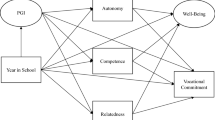Abstract
Tinto postulates that students enter college with expectations. If these expectations are unmet, there is early disenchantment with the social and academic communities. Such disenchantments hinder academic and social integration which, in turn, influence subsequent institutional and goal commitments and ultimately student departure. These formulations are tested in a multi-institutional study of 263 first-time freshmen who entered four-year colleges and universities. The findings indicate that both academic and social integration are positively influenced by the meeting of expectations for academic and career development. Social integration is positively influenced by expectations for opportunities for personal involvement, but negatively affected by expectations for a collegiate atmosphere. Indirect effects on intentions to remain in the focal college are indirectly influenced by collegiate atmosphere and academic and career development. Implications for enrollment management and the development of linkages between theories of college choice and student departure are drawn.
Similar content being viewed by others
References
Attinasi, L. C. (1989). Getting in: Mexican Americans' perceptions of university attendance and the implications for freshmen year persistence.Journal of Higher Education 60: 247–277.
Bean, J. P. (1980). Dropouts and turnover: The synthesis and test of a causal model of student attrition.Research in Higher Education 12: 155–187.
Bean, J. P. (1983). The application of a model of turnover in work organizations to the student attrition process.Review of Higher Education 60: 155–182.
Bers, T. H., and K. E. Smith (1991). Persistence of community college students: The influence of student intent and academic and social integration.Research in Higher Education 32(5): 539–556.
Braxton, J. M., and E. M. Brier (1989). Melding organizational and interactional theories of student attrition: A path analytic study.Review of Higher Education 13: 47–61.
Braxton, J. M., E. M. Brier, and D. Hossler, (1988). The influence of student problems on student withdrawal decisions: An autopsy on “autopsy studies.”Research in Higher Education 28(3): 241–253.
Cabrera, A. F., M. B. Castaneda, A. Nora, and D. Hengstler (1992). The convergence between two theories of college persistence.Journal of Higher Education 63(2): 143–164.
Cabrera, A. F., A. Nora, and M. B. Castaneda (1992). The role of finances in the persistence process: A structural model.Research in Higher Education 33(5): 571–593.
Chapman, D. W., and E. T. Pascarella (1983). Predictors of academic and social integration of college students.Research in Higher Education 19: 295–322.
Hossler, D., and J. P. Bean (1990). Principles and objectives. In Don Hossler and John P. Bean (eds.),The Strategic Management of College Enrollments, pp. 3–20. San Francisco: Jossey-Bass.
Hossler, D., J. M. Braxton, and G. Coopersmith (1989). Understanding student college choice. In John C. Smart (ed.),Higher Education: Handbook of Theory and Research, vol. 5, pp. 231–288. New York: Agathon Press.
Hossler, D., and K. S. Gallagher (1987). Studying student college choice. A three phase model and the implications for policy makers.College and University 2(3): 207–222.
Joreskog, K., and D. Sorbom (1984).LISREL VI: An Analysis of Linear Structural Relationships by Maximum Likelihood, Instrumental Variables, and Least Squares Methods. Mooresville, IN: Scientific Software, Inc.
Joreskog, K., and D. Sorbom (1988).PRELIS: A Program for Multivariate Data Screening and Data Summarization, 2nd ed. Mooresville, IN: Scientific Software, Inc.
Joreskog, K., and D. Sorbom (1989).LISREL VII. Mooresville, IN: Scientific Software, Inc.
Kemerer, F., J. V. Baldridge, and K. Green (1982).Strategies for Effective Enrollment Management. Washington, DC: American Association of State Colleges and Universities.
Kim, J. O., and C. W. Mueller (1978).Factor Analysis: Statistical Methods and Practical Issues. Beverly Hills, CA: Sage Publications.
Lazarsfeld, P. (1959). Problems in methodology. In Robert K. Merton (ed.),Sociology Today. New York: Basic Books.
Munro, B. (1981). Dropouts from higher education: Path analysis of a national sample.American Educational Research Journal 81: 133–141.
Pascarella, E. T., and D. W. Chapman (1983). A multi-institutional path analytic validation of Tinto's model of college withdrawal.American Educational Research Journal 20: 87–102.
Pascarella, E. T., P. Duby, and B. Iverson (1983). A test and reconceptualization of a theoretical model of college withdrawal in a commuter institution setting.Sociology of Education 56: 88–100.
Pascarella, E. T., and P. T. Terenzini (1980). Predicting persistence and voluntary dropout decisions from a theoretical model.Journal of Higher Education 51: 60–75.
Spady, W. (1970). Dropouts from higher education: An interdisciplinary review and synthesis.Interchange 1:64–85.
Stage, F. K. (1989). Motivation, academic and social integration, and early dropout.American Educational Research Journal 26(3): 385–402.
Stage, F. K. (1990). LISREL: An introduction and applications in higher education. In J. C. Smart (ed.),Higher Education: Handbook of Theory and Research, vol. 6, pp. 427–466.
Stoecker, J., E. T. Pascarella, and L. M. Wolfle (1988). Persistence in higher education: A 9-year test of a theoretical model.Journal of College Student Development 29(3): 196–209.
Terenzini, P. T., E. T. Pascarella, C. Theophilides, and W. G. Lorang (1985). A replication of a path analytic validation of Tinto's theory of college student attrition.Review of Higher Education 8: 319–340.
Tinto, V. (1975). Dropout from higher education: A theoretical synthesis of recent research.Review of Educational Research 45: 89–125.
Tinto, V. (1986). Theories of student departure revisited. In John C. Smart (ed.),Higher Education: Handbook of Theory and Research, vol. 2, pp 359–384. New York: Agathon Press.
Author information
Authors and Affiliations
Additional information
An earlier version of this article was presented at the annual meeting of the American Educational Research Association, Atlanta, GA, April 12–16, 1993.
Rights and permissions
About this article
Cite this article
Braxton, J.M., Vesper, N. & Hossler, D. Expectations for college and student persistence. Res High Educ 36, 595–611 (1995). https://doi.org/10.1007/BF02208833
Issue Date:
DOI: https://doi.org/10.1007/BF02208833




